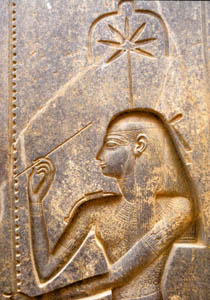Lecture 1--Introduction and Orientation--Women in Literature page 2 Seshat of Ancient Egypt Contents of this Lecture: We continue with an image from the distant past, one of the first
women writers, no doubt, Seshat, the consort of the God of Writing, Thoth.
Although it would appear that the occupation of the scribe was primarily a
male monopoly, this image of Seshat gives us an indication that a female
could, it seems, learn to write. Seshat is wearing a headdress of a
seven-pointed star has a palm branch, a writing pen and palette,
papyrus scrolls and books. This image of Seshat brings us to the first of the questions which we may not be able to answer, at least within the confines of this course, and that is: how much of the truth do we have about ancient women writers? We know that the muse of History (Cleo, another woman) is a fickle Goddess. Even a look at our own past experiences, and a comparison with the way that the media covers them later, gives us an idea of the way that information mutates in the preservation process. This is not to say that the history of women is any different than any other history in terms of its preservation process. But of all of the social and custom-based biases that we can trace over the time of our written history, women have been relegated to a secondary status, far from the power that has been incorporated, specifically, in the means of making the history, the written word. En-hedu-anna Even as Seshat was of divine origin, we also have evidence of women of antiquity who were real. En-hedu-anna was possibly the first human woman writer, and in any case, she is the first that we have authorial evidence concerning. That is, despite the fact that you have probably never heard the name, En-hedu-anna is the earliest known author, male or female. from the Women Writer's Site (no longer active) -- this summary: Both of her parents are purported to have been born of priestess mothers.
And in her Biography, Binkley relates in particular a story that includes what appears to be the
precursor to the Moses story in reverse. Found on a cuneiform tablet apparently carved by Sargon
himself, the story relates his secret birth to a priestly mother who sets him in an ark of
bulrushes, consigning him to the river where he is found by a kind farmer who
raises him as his own. His greater destiny of course (assisted by the Goddess Ishtar) is to rule. an alternate Women
Writer's Project at Brown University
Disk of Enheduanna at Offering Enheduanna (later 2300s or early 2200s BCE) was the daughter of
Sargon, the ruler of Akkad - during ancient Sumerian times.
Here is a sample of her poetry: I, what am I among the living creatures! More on this early woman writer can be found at The En-hedu-anna's Reserach Pages. One puzzling aspect of this hymn is the sense that Enheduanna's
lament is not so much bitter because she was a woman, but because she was
defeated by her enemies. This would suggest that a daughter of a
king, at least, might have learned to read and write and be admitted to
the priesthood. Throughout the early records we do have evidence of
high-born women receiving an education, often quite an elaborate one, from
a prominent father. We cannot be sure, then, whether the instance of
works like this is due to the fact that Enheduanna was a Princess, or if
there were, in fact, other women writing in very early times whose works
were not preserved. Because of the social status of women, too, when the text is not attributed to someone whose Name is otherwise linked to the dominant history, the writing we have is often anonymous--so that the earliest voices come without names--here is a poem from the ArtGrrrrl website (no longer active) - an Inuit (Eskimo) poem from the far north: Far Inland (Inuit) Another feature of the woman writer, early and late, is the origin in some kind of specialized living situation. Nuns of the Middle Ages were often literate, and, when they were allowed to, wrote beautiful spiritual and practical tracts. Women in harems, too, often had the leisure, education, and means to write. The art of poetry was seen in these situations as an attractive addition to other charms a courtesan might possess. As we trace the history of women writers, we will
continue to find that the work we now treasure seems to have had some
particular reason for preservation, that the authors might have come from exalted
families, and that they often lived lives that diverged from the
common patterns of womanhood. It is only much later, when access to
the very tools of writing are democratized, that we see a phenomenon such
as the Bronte Sisters.
|
|
Literature 45 - Women in Literature : Marjorie C. Luesebrink, MFA Contents: Announcements // Discussion Page // About Your Class // Class Syllabus // Lecture Notes // Discussion Group // Reading List // Recommended Reading // Assignments // Resources and Web Sites // Grading Policies // Contact Your Instructor
|
 SSeshat,
the goddess of the Library
SSeshat,
the goddess of the Library

